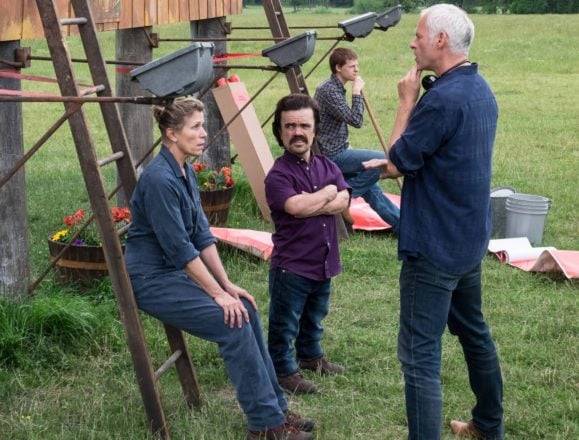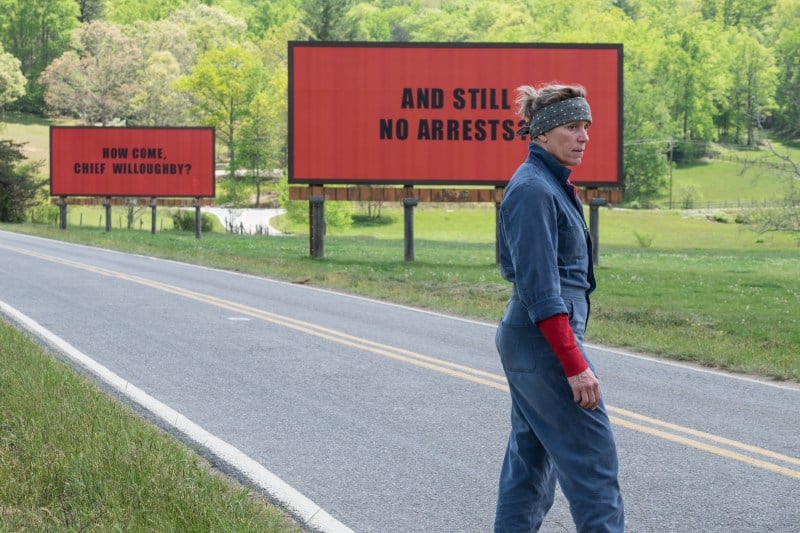The people I feel closest to in “Three Billboards outside Ebbing, Missouri” are the people who don’t talk.
The extras. The supernumerary actors, or “supers.”
This diverse crew of background players (black, white, Mexican, cameramen, school moms) often don’t have lines or names. But they’re our way into this intriguing film, Martin McDonagh’s sometimes-annoyingly-2017 update on the theme of Little Gal/Guy versus the System. The supers look on in wide-mouthed horror when men are thrown out of windows, beat to a bloody pulp or kicked in the balls by a jaded mom, the town pariah. In a way, we are those nameless supers: gawking (or looking away), mouth agape at the willful nastiness of this small-town film.
In “Three Billboards,” McDonagh gives the classic Jean Renoir motto “everybody has their reasons” an anti-Renoir approach. Instead of Renoir’s soft, flux-like people drawn with pastel hues of patience, McDonagh’s people are talky political abstracts who are either violently one thing or violently another. The “Three Billboards” player is hateful first, pretty loathsome second, human last (very, very last). Whereas Renoir would take us within the French character, McDonagh is wary of American interiority, so he keeps his camera neatly on the outside; with the exception of McDormand, we never feel like we inhabit a world through the characters.
That’s perhaps the biggest flaw of this Icarus film’s high sights. It’s guided by the spirits of two key masters of the American vernacular: photographer Walker Evans and writer Flannery O’Connor. To help, the film brings into the fold a modern master of her own: resolute Frances McDormand, who centers the work as she did “Olive Kitteridge” (2014) and “Fargo” (1996). She plays Mildred Hayes, the mother of a teenager named Angela, who was brutally raped and murdered (burned alive — the body, charred beyond recognition) on a stretch of road, lined with three decrepit billboards, outside the titular town. Seven months on, the town’s chief of police Willoughby (Woody Harrelson) has not come closer to arresting the man responsible. Before Mildred hatches her Big Plan, the billboards resemble an Evans photo: oddball snatches of capitalist ad talk (“of your life!” “worth shopping for”) and wonderfully weird imagery that stands outside of time-space-place (the body of a cherubic 50s-era baby is split in two, like a Cubist painting, by modern graffiti tags).
After Mildred’s Big Plan, “Three Billboards” quickly morphs into a Walker Evans picture gone wrong. The billboards’ content is more fantastical and showy than anything Evans would have cared to touch: three electric-red billboards, on the same road where Angela was found, each more cutting than the last: “RAPED WHILE DYING” — “AND STILL NO ARRESTS?” — “HOW COME, CHIEF WILLOUGHBY?”
O’Connor, too, is a silent witness to the grotesquerie of “Three Billboards.” When Mildred enters the advertising agency to rent out the billboards, the head of the company, Red (Caleb Landry Jones), is seen reading O’Connor’s 1955 short story “A Good Man is Hard to Find.” McDonagh throws down one hell of a challenge for himself: Conjure up the precision of O’Connor’s world for modern 2017. Cruel people in a cruel world whose fleeting revelations (of a divine nature in O’Connor but never in McDonagh) only accentuate the cruelty. O’Connor would have made a great story out of only one of the various incidents smashed together in “Three Billboards”: Mildred drives a dentist’s drill into his thumb, Officer Dixon (Sam Rockwell) throws Red from his second-story office window and punches out his hapless assistant Pamela, a stupidly corny deer, an even stupider caricature of Millennials (two of the film’s falsest notes), countless counts of arson, American imperialist wrong-doings and suicides. (But the best O’Connor-like details are, of course, the subtlest: a knockout shot of a gentle turtle on the lap of sleeping Momma Dixon, a cigar-store Ma Jarrett played with steely gruffness by Sandy Martin.)
Evans’ strength was his pithiness. O’Connor’s strength was her lack of sentiment. Martin McDonagh’s weakness is his treacle-filled talk. The screenplay and the plot-beats are often unforgivably overworked, arrogant and strained. Certain lines are grooved to score quick, cheap, political points at the expense of an organic scenario and a proper arena for the actors to riff. These annoyingly on-the-nose coincidences just pile up on a second viewing:
(1) Pamela’s needlessly specific mention of a fat little Mexican boy (“on a bike!”)
(2) Penelope, the vapid and chattering Millennial stereotype who can’t tell the difference between polo and polio. It’s a condescending character, always cringe-worthy
(3) The bit about “persons of color torturing!” (“because,” sez Rockwell, “ya can’t say nigger-torturin’ anymore!” — har har, pee see, snicker snicker)
(4) The film’s only flashback, to the last time Mildred saw Angela alive. “I hope I get raped on the way there!” Angela says. “Yeah, well, I hope you get raped on the way, too!” Mildred hollers back.
(5) Cornball symbolism, like a teddy bear on the shore, horses grazing, an upside-down beetle, an endless stream of letters to move the plot artificially forward and that damn deer (K. Austin Collins is on point when he says the deer scene was ready-made for McDormand’s Oscar reel)
(6) Certain moments involving the Sam Rockwell sheriff, who is beautifully acted yet forced into situations that I couldn’t accept (based on what we’ve seen in the first half, can we believe that Willoughby thinks Dixon has any makings of a great detective?)

Though it’s one of the most sanctimonious and overworked things I’ve seen this year, a great deal of “Three Billboards” works thanks to the actors in the small-town setting. I expected the Ebbing scandal to somehow spiral out of control and become some national phenomenon; it doesn’t. Only one plucky morning-TV reporter is covering it. What’s interesting is seeing how the Ebbing townsfolk react to the Billboard saga: from punishments as petty as tossed milk on Mildred’s car, to toxic threats from a man who whispers in Mildred’s ear: “I didn’t rape your daughter, but I would have liked to.” This town and its folks are small, unkempt, never-changing. Ebbing, Missouri tries to present itself as one thing but can’t conceal its pseudo-“Blue Velvet” rottenness. Ebbing thinks of itself as a town where everyone can speak on the level, where churchgoers are as rosy as the glossy “Welcome to Ebbing, Missouri” sign that looks like it was preserved in Coca-Cola-syrup since the 1950s. In reality, the real Ebbing is in the very first shot of the film: “Ebbi—”, a half-stratched-off, unreadable piece of billboard paper, whose history and memory is constantly forgotten as more people paste their 10-words-or-fewer ads over it.
But not Mildred; Mildred’s going to give the town something worth remembering.
The biggest draw of the film is by far the implosive performance from Frances McDormand. With the relish she gave her character in the four-hour HBO epic “Olive Kitteridge,” she inhabits the tightly-written role of a mother protecting the public afterlife of a daughter who privately hated her while alive. Her brutally unchanging costume is always fresh: blue overalls, tough bandana, burnt-hair ponytail chopped off to make her look like a Toshiro Mifune samurai but with a drained-of-color face that betrays the thickness of her skin. McDormand puts Mildred’s scary immobility to good use: While drilling holes into dentists’ thumbs (obvious), she also pokes holes into Woody Harrelson by scanning relentlessly around his bald head with the deep darkness of her eyes (subtle). Mildred always has the upper hand without ever having to move or stand up. The good, quiet, wordless images by Ben Davis catch the sitting Mildred during powerful moments at a breakfast nook (white harsh morning light, hair in a tired natty tangle) and at the window of a gift shop (profile, drenched in black as the sun sets on a eventful day, pondering in secular loneliness why the town hates her guts).
Even the McDonagh script can’t bring McDormand down. The fatuous anti-Catholic Church monologue, which works under a presumption that it’s uncovering radical truths, is saved by McDormand’s rambling delivery. She’s why I’m utterly convinced that McDonagh’s words have been stewing in this atheist for a damn long time. Sometimes, all it takes is her pure delivery to escape the confines of the script. Among the best fusions of tragicomedy in “Three Billboards”: Mildred crying and slumped up in bed, having a conversation with her two bunny-sandals in a creepy, baby Elmo voice: “We gonna crucify the motherfuckers? Thaaaat’s right—I’m’unna crucify the motherfuckers!” while Carter Burwell’s serious, wintery piano chords play as a fantastic counter.
McDonagh’s handling of other supporting actors also shows a deep interest in character that his obsession with words rarely suggests. Peter Dinklage’s puppy-dog niceness is a highlight: The relish he takes in his scenes with McDormand and his goofball demeanor (“I like cheesy things”) is a strong counterbalance to the constraints of the sophomoric humor (“I have to go to the little boys’ room”). Likewise, Sam Rockwell acts a believably lumbering mess. His key weapon is a big-cat prowl, walking like a semi-drunken John Wayne on his way to beat up Red and Pamela. He always needs to take command of the space around him, but it is never his to command in the first place. Look at the brilliant way he fumbles with a metal chair when accosted by McDormand; it’s gut-busting. Near the end, Rockwell has an amazing tête-à-tête with a gun-barrel — fondling, kissing, leaning it against his forehead — that makes us seriously question his state of mind: “Is he thinking what I think he’s thinking?”
This mistrust of a person’s consciousness is at the infrequent heart of “Three Billboards.” Like O’Connor’s Catholic stories, “Three Billboards” uncovers a world of people who are sickeningly callous or self-involved on the surface but who conceal a frightened, vulnerable underbelly. One’s public image of oneself never matches up with one’s private thoughts: TV, radio and billboards say one thing, but an understanding letter between passive-aggressive friends says another. Maybe that’s why McDonagh rejects Renoirian interiority: He may think it’s dishonest to be anything but hopelessly outside a person, place, subject. Maybe that’s why the turtle is worthy of O’Connor — a moment of respite that is at stark odds to the vile, petty, violent rage of the human heathens in Ebbing.
But why do the heathen rage? And who has the more honest, meatier answer? Does “timely” mean “better”?
“Three Billboards outside Ebbing, Missouri” plays at the Aquarius in Palo Alto and Cinemark Downtown 20 in Redwood City.
Contact Carlos Valladares at cvall96 ‘at’ stanford.edu.
